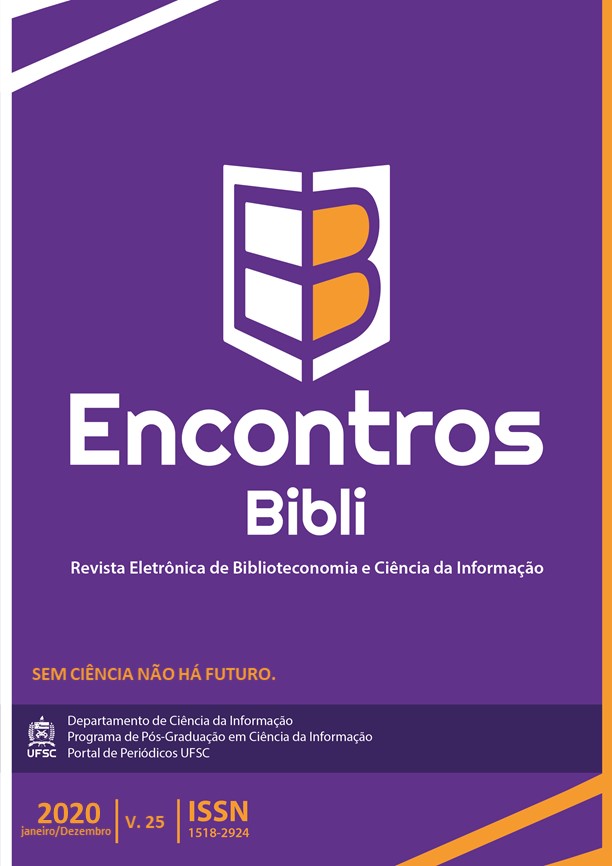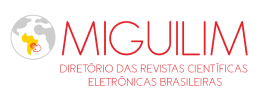Architecture for the integration of geographic digital libraries through geoprocessing mechanisms in the context of information science
DOI:
https://doi.org/10.5007/1518-2924.2020.e70807Keywords:
Digital Geographic Library, Geoprocessing, Geographic Information System, GIS, Metadata, Geo-ontologyAbstract
Objective: Build a conceptual architecture, with elements for the creation of a Digital Geographic Library, using the patterns and concepts of Information Science in conjunction with Geoprocessing.
Methods: Through a theoretical, exploratory and bibliographic study in the areas of Information Science and Geoprocessing, it was possible to develop a conceptual model of architecture for the Digital Geographic Library. The proposal was structured in three layers: the Client, responsible for the visualization process; the Application, which has the management and analysis processes; and the data layer, which includes Web data services, focused on the recovery of metadata, via the PMH protocol (Protocol Metadata Harvesting).
Results: The conceptual architecture created met the information representation requirements, the forms of communication with the metadata and digital objects collection protocol, thus enabling the sharing of geographic information collections distributed in different Geographic Digital Libraries around the world. The informational elements focused on Geoprocessing and the thematic and descriptive forms of organization and information retrieval of Information Science confirmed the potential for reciprocal and shared use of concepts and tools from these two areas.
Conclusions: The main aspects of the research were: with the implementation of the three layers and four processes, it is possible to use geographic information systems and user interface applications to facilitate the process of sharing and retrieving information. Using the manager and the metadata standard provides accurate information retrieval, along with the unique geo-ontology editor for all participating libraries.
Downloads
References
ABAD, F.; GARCÍA-CONSUEGRA, J.D.; MARTÍNEZ, A. Una Introducción a las bibliotecas digitales geográficas. JBIDI: Primeras Jornadas de bibliotecas digitales, nov. 2000.
ALVARENGA, L. A teoria do conceito revisitada em conexão com ontologias e metadados no contexto das bibliotecas tradicionais e digitais. DataGramaZero, v.2, n.6, dez. 2001. Disponível em: http://www.dgz.org.br/dez01/Art_05.htm. Acesso em: jan. 2005.
CÂMARA, G. Representação computacional de dados geográficos. In: CASANOVA, M. A. et al. Banco de dados geográficos. Curitiba: Mundogeo, 2005, p. 11-52.
CASANOVA, M. A. et al. Integração e interoperabilidade entre fontes de dados geográficos. In: CASANOVA, M. A. et al. Banco de dados geográficos. Curitiba: Mundogeo, 2005, p. 315-352.
FGDC (Federal Geographic Data Committee), 2019. Disponível em: https://www.fgdc.gov/metadata. Acesso em: jul. 2019.
FONSECA, F.; EGENHOFER, M.; BORGES, K. Ontologias e interoperabilidade semântica entre SIGs. In: WORKSHOP BRASILEIRO EM GEOINFORMÁTICA (GEOINFO), 2., São Paulo, 2000. São José dos Campos: INPE, 2000. p.45-52.
GARDELS, K. Open GIS and on-line environmental libraries. ACM SIGMOD Record. v. 26, p.32-38. 1997. doi: https://doi.org/10.1145/248603.248610
ISO 19115-1:2014. Geographic information - Metadata - Part 1: Fundamentals.
ISO 19115-2:2019. Geographic information - Metadata - Part 2: Extensions for acquisition and processing.
ISO/TS 19115-3:2016. Geographic information - Metadata - Part 3: XML schema implementation for fundamental concepts.
LING, J.; JIANYA, G.; BIN, L.; MIN, M. GeoReferencing the Semantic Web Based on Geoontology. IEEE International Symposium on Geoscience and Remote Sensing, Denver, CO, 2006, pp. 1545-1548, doi: 10.1109/IGARSS.2006.398.
OLIVEIRA, J.P.M.; LAMB, L.C. Um framework de apoio à colaboração no projeto distribuído de sistemas integrados. Revista de Informática Teórica e Aplicada e as Tecnologias de Informação, v. 8, n. 1, 2001.
OSSES, J.R.; PAIVA, J.A.C; CÂMARA, G. Arquiteturas cliente-servidor para bibliotecas geográficas digitais. In: BRAZILIAN SYMPOSIUM ON GEOINFORMATICS (GEOINFO), 2. 2000. Disponível em: http://www.geoinfo.info/proceedings_geoinfo2000.split/paper9.pdf. Acesso em: jul. 2019.
PAYETTE, S.; BLANCHI, C.; LAGOZE, C.; OVERLY, E.A. Interoperability for digital objects and repositories. D-Lib Magazine, v. 5, n.5, 1999. ISSN 1082-9873. Disponível em: http://www.dlib.org/dlib/may99/payette/05payette.html. Acesso em: jun. 2020.
ROSENFELD, L; MORVILLE, P; ARANGO, J. Information architecture: For the Web and beyond. Canadá: O’Reilly Media, 2015.
SENSO, J.A.; ROSA PIÑERO, A. de la. El concepto de metadato - algo más que descripción de recursos electrónicos. Revista Ciência da Informação, Brasília, v. 32, n.2, p.95-106, 2003.
SMITH, B.; MARK, D. Ontology e geographic kinds. In: INTERNATIONAL SYMPOSIUM ON SPATIAL DATA HANDLING. VANCOUVER, Canadá, 1998. p.308-320. Disponível em: http://www.dpi.inpe.br/gilberto/references/SmithMark_SDH1998.pdf. Acesso em: jul. 2019.
TAKAHASHI, T. (Org.). Sociedade da informação no Brasil. Brasília: Ministério da Ciência e Tecnologia, 2000.
TAMBASSI, T. A Geographical taxonomy for geo-ontologies. Axiomathes 27, 355–374 (2017). Disponível em: https://link.springer.com/article/10.1007/s10516-016-9309-z. Acesso em jun. 2020.
TOLK, A. D., DIALLO, S. Y., TURNITSA, C. D. Applying the Levels of Conceptual Interoperability Model in Support of Integrability, Interoperability, and Composability for Systems of Systems Engineering. Systemics, Cybernetics and Informatics, v. 5, no. 5, 2007.
VIDOTTI, S. A. B. G. et al. Web, Web Semântica e Web Pragmática: um posicionamento da Arquitetura da Informação. Informação & Sociedade, João Pessoa, v. 29, n. 1, 2019.
WEBER, E.; ANZOLCH, R.; LISBOA FILHO, J.; COSTA, A.C.; IOCHPE, C. Qualidade de dados geoespaciais. UFRGS. 1999. Disponível em: https://www.researchgate.net/publication/317385706_Qualidade_de_Dados_GeoespaciaisAcesso em: jul. 2019.
Downloads
Published
How to Cite
Issue
Section
License
Copyright (c) 2020 Marcel Santos Silva, Silvana Aparecida Borsetti Gregorio Vidotti

This work is licensed under a Creative Commons Attribution 4.0 International License.
The author must guarantee that:
- there is full consensus among all the coauthors in approving the final version of the document and its submission for publication.
- the work is original, and when the work and/or words from other people were used, they were properly acknowledged.
Plagiarism in all of its forms constitutes an unethical publication behavior and is unacceptable. Encontros Bibli has the right to use software or any other method of plagiarism detection.
All manuscripts submitted to Encontros Bibli go through plagiarism and self-plagiarism identification. Plagiarism identified during the evaluation process will result in the filing of the submission. In case plagiarism is identified in a manuscript published in the journal, the Editor-in-Chief will conduct a preliminary investigation and, if necessary, will make a retraction.
This journal, following the recommendations of the Open Source movement, provides full open access to its content. By doing this, the authors keep all of their rights allowing Encontros Bibli to publish and make its articles available to the whole community.
Encontros Bibli content is licensed under a Creative Commons Attribution 4.0 International License.
Any user has the right to:
- Share - copy, download, print or redistribute the material in any medium or format.
- Adapt - remix, transform and build upon the material for any purpose, even commercially.
According to the following terms:
- Attribution - You must give appropriate credit, provide a link to the license, and indicate if changes were made. You may do so in any reasonable manner, but not in any way that suggests the licensor endorses you or your use.
- No additional restrictions - You may not apply legal terms or technological measures that legally restrict others from doing anything that the license permits.

























